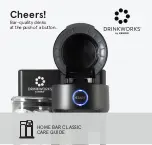
5 User interface
Installation and operation manual
14
REMA5+REYA8~20A7Y1B
VRV 5 heat recovery
4P684060-1 – 2022.02
NOTICE
For future modifications or expansions of your system:
A full overview of allowable combinations (for future
system extensions) is available in technical engineering
data and should be consulted. Contact your installer to
receive more information and professional advice.
The VRV 5 uses R32 refrigerant which is rated as A2L and is mildly
flammable. For compliance with the requirements for enhanced
tightness refrigerating systems and IEC60335-2-40 the installer must
take extra measures. For more information, see
equipment using R32 refrigerant"
The indoor unit part of this VRV 5 heat recovery system can be used
for heating/cooling applications. The type of indoor unit which can be
used depends on the outdoor units series.
4.1
System layout
Your VRV 5 heat recovery series outdoor unit can be one of
following models:
Model
Description
REYA8~20
Heat recovery model for single or multi-use
REMA5
Heat recovery model for multi-use only
Depending on the type of outdoor unit which is chosen, some
functionality will or will not exist. It will be indicated throughout this
operation manual when certain features have exclusive model rights
or not.
The complete system can be divided into several sub-systems.
These sub-systems have 100% independence regarding the
selection of cooling and heating operation, and each consists of one
individual branch set of a BS unit, and all indoor units connected
downstream.
INFORMATION
The following figure is an example and may NOT
completely match your system layout
c
b
a
d
e
g
i
f
e
d
c
c
d
e
h
i
i
a
Heat recovery outdoor unit
b
Branch selector (BS)
c
Refrigerant piping
d
VRV direct expansion (DX) indoor unit
e
Remote controller in normal mode
f
Remote controller in
alarm only mode
g
Remote controller in
supervisor mode
(mandatory in
some situations)
h
iTM (optional)
i
Option PCB (optional)
5
User interface
CAUTION
▪ NEVER touch the internal parts of the controller.
▪ Do NOT remove the front panel. Some parts inside are
dangerous to touch and appliance problems may
happen. For checking and adjusting the internal parts,
contact your dealer.
This operation manual offers a non-exhaustive overview of the main
functions of the system.
Detailed information on required actions to achieve certain functions
can be found in the dedicated installation and operation manual of
the indoor unit.
Refer to the operation manual of the installed user interface.
6
Operation
6.1
Operation range
Use the system in the following temperature and humidity ranges for
safe and effective operation.
Cooling
Heating
Outdoor temperature
–5~46°C DB
–20~20°C DB
–20~15.5°C WB
Indoor temperature
21~32°C DB
14~25°C WB
15~27°C DB
Indoor humidity
≤80%
(a)
(a)
To avoid condensation and water dripping out of the unit. If the
temperature or the humidity is beyond these conditions, safety
devices may be put in action and the air conditioner may not
operate.
Above operation range is only valid in case direct expansion indoor
units are connected to the VRV 5 system.
6.2
Operating the system
6.2.1
About operating the system
▪ Operation procedure varies according to the combination of
outdoor unit and user interface.
▪ To protect the unit, turn on the main power switch 6 hours before
operation.
▪ If the main power supply is turned off during operation, operation
will restart automatically after the power turns back on again.
6.2.2
About cooling, heating, fan only, and
automatic operation
▪ Changeover cannot be made with a user interface whose display
shows
"change-over under centralised control" (refer to
installation and operation manual of the user interface).
▪ When the display
"change-over under centralised control"
flashes, refer to
"6.5.1 About setting the master user
▪ The fan may keep on running for about 1 minute after the heating
operation stops.
▪ The air flow rate may adjust itself depending on the room
temperature or the fan may stop immediately. This is not a
malfunction.
6.2.3
About the heating operation
It may take longer to reach the set temperature for general heating
operation than for cooling operation.
The following operation is performed in order to prevent the heating
capacity from dropping or cold air from blowing.















































